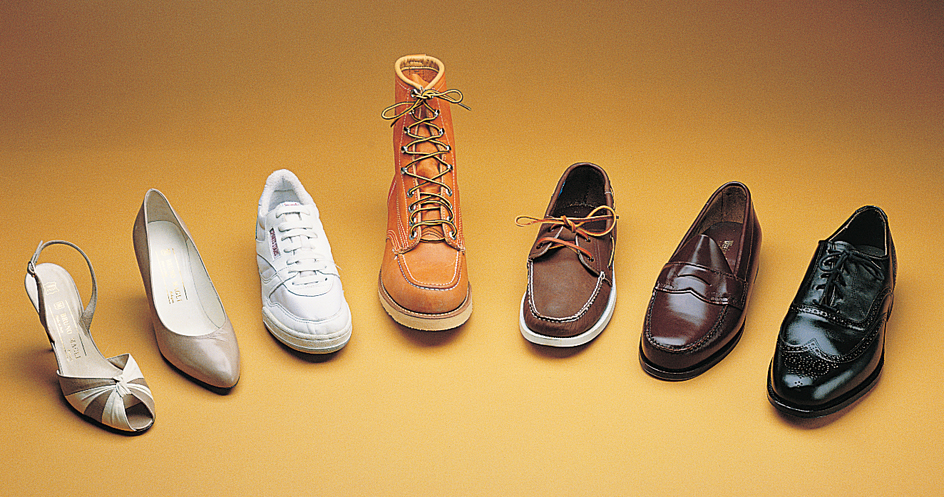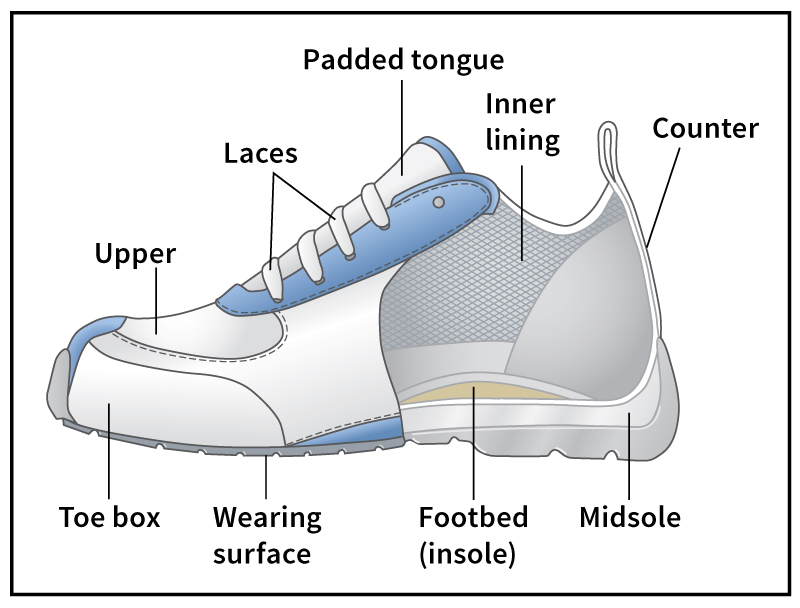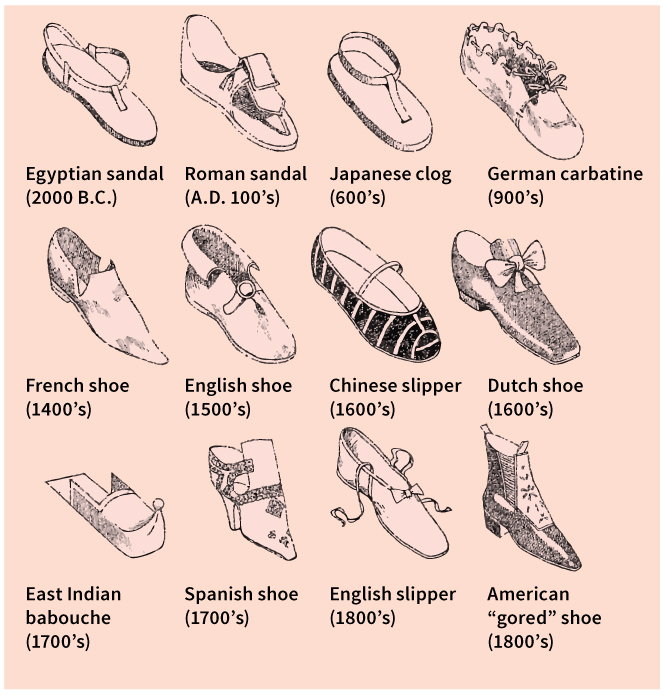Shoe is a covering for the foot. Shoes have a sole, and most shoes also have a heel. The upper part of most shoes extends no higher than the ankle. Boots are footwear that reach beyond the ankle. People wear shoes in order to protect their feet from the environment, sharp objects, and uncomfortable surfaces.

Fashion often determines shoe styles. The desire to be fashionable has led to unusual styles. For example, many European men of the 1300’s wore shoes called crackowes, which had an extremely long toe. Some crackowes had a toe so long that it had to be fastened to the knee with a chain to prevent the wearer from tripping. From the 1300’s to the 1700’s, some European women wore shoes with soles so thick that walking was impossible without support. Shoes once worn in Japan were connected to stilts as high as 6 inches (15 centimeters).
Most shoes are made of leather. Other shoe materials include canvas, velvet, and such synthetic substances as plastics. Materials and styles vary somewhat, depending on climate, custom, and other factors. For example, many farmers in the Netherlands wear heavy wooden shoes to protect their feet from the damp ground. Many Japanese wear shoes outside their home but prefer soft slippers at home.
Kinds of shoes.
There are four main kinds of shoes: (1) casual and dress shoes, (2) sport shoes, (3) work shoes, and (4) corrective shoes.
Casual shoes and dress shoes
are made for most everyday occasions. Most casual shoes are low-heeled styles, such as the loafer, moccasin, oxford, and pump. Oxfords feature a lacing over a tongue. Loafers, moccasins, and pumps are slip-on shoes. Most slip-on shoes have no lace or tongue.

Most dress shoes, or evening shoes, for women are based on the pump or sandal style and have high or medium heels. Materials used for these shoes include brocade, satin, silk, tapestry, and velvet. Some men’s dress shoes are made of patent leather (leather with a glossy finish).
Sport shoes
are designed to enhance the performance of athletes and to provide comfort and durability. They have different features for various sports. Basketball shoes and tennis shoes have rubber soles that keep the player from slipping. These soles also prevent the shoes from damaging the playing surface. Baseball shoes have metal or synthetic-rubber spikes that enable the wearer to start and stop quickly. Football shoes have synthetic-rubber cleats for the same purpose.

Beginning in the 1960’s, more and more people, especially in the United States, became interested in personal fitness. As a result, shoe manufacturers began to produce highly specialized athletic shoes for such activities as running, walking, and aerobic exercise. In addition, cross-training shoes are designed to be appropriate for play of more than one sport. Many people wear athletic shoes for casual dress as well as for sports and other exercise.
Work shoes
are worn for safety and comfort in many kinds of jobs. Workers in some industries wear shoes with a steel toecap for protection against injury. Other workers wear footwear designed to prevent burns, to prevent slipping, or to protect the wearer from electrical shock. Most mail carriers, nurses, restaurant workers, and others who must stand or walk for long periods wear shoes that have a cushioned sole.
Corrective shoes
are designed to provide relief from such foot conditions as bunions and corns (see Bunion; Corn). They also are used for hammertoes (toes bent in the form of a claw) and other disorders. Some corrective shoes are ready-made products that have built-in corrections for minor foot problems. For example, one style features a special heel that supports the arch, the curved part of the sole of the foot. Other corrective shoes are specially made for one person, some according to a physician’s prescription. A person can also have special shoes made to fit the exact shape of the feet—including any corns or other bulges. Such shoes reduce the pressure against these areas.
Shoe manufacturing
requires dozens of operations, many of which are highly skilled. First a shoe designer, who generally works for a shoe manufacturer, makes sketches of ideas and decides what colors and materials will be used. The manufacturer produces samples of the shoes, and sales representatives show the samples to buyers from shoe and department stores. The buyers then order shoes from the manufacturer.
At the shoe factory, workers prepare patterns for each component of each size shoe to be manufactured. Using patterns, a worker then cuts sections that will form the upper (upper part) of the shoe. The sections of the upper are then joined together by stitching or cementing. Next, the upper is pulled over a last (a plastic form in the approximate shape of a foot) on a lasting machine. A worker then attaches the sole to the upper by stitching, cementing, or molding. Finally, the heel is attached and various finishing operations are carried out.
Shoes and health.
Shoes that have been poorly fitted can cause such problems as backaches, sore muscles, fatigue, and poor posture. Shoes that are too tight may result in corns, hammertoes, and ingrown toenails. People can avoid such problems by taking special care when buying shoes, especially children’s shoes. Most children outgrow their shoes within a few months.
Shoes should have a space of 1/2 to 3/4 inch (13 to 19 millimeters) between the tip of the big toe and the shoe. Most people have one foot larger than the other, and so both feet should be fitted. A person should walk around while trying on new shoes to ensure a comfortable fit.
Some people wear certain fashionable shoes even though these shoes are uncomfortable and can hurt the feet. For example, high heels can cramp the toes by pushing the feet forward. Pointed shoes also crowd the toes. Shoes with hard, thick soles can prevent flexible movement. Hot feet can result from shoes that do not breathe (allow foot moisture to escape). Some synthetic materials do not breathe as well as leathers.
History.
No one knows when people first began to wear shoes. The first foot coverings worn in cold regions were probably baglike wrappings made of animal fur. The first known footwear used in warm surroundings consisted of sandals made of plant fibers or leather. The ancient Egyptians wore such sandals as early as 3700 B.C., and the ancient Greeks and Romans also wore sandals. In China, people wore wooden-soled shoes and cloth shoes thousands of years ago.
Throughout history, people have worn shoes not only for protection but also for decoration and to indicate social status. Shoe styles have gone in and out of fashion, just as they do today. For example, the fashion in women’s shoes changed to rounded toes in the 1500’s, low heels by the late 1500’s, and high heels in the 1600’s.

The Indians of North America made moccasins of animal skins. The Europeans who settled in the New World wore sturdy leather shoes most of the time, but some colonists also wore moccasins.
Until the mid-1800’s, despite the many changes in shoe styles, shoemaking itself involved chiefly the use of simple hand tools. Most people wore homemade shoes or bought shoes from a shoemaker who lived nearby or traveled from house to house. Improved sewing machines were developed in the mid-1800’s, and shoemaking became a factory operation. These machines had special devices to stitch shoe parts that previously had required nailing or stitching by hand.
In 1882, Jan Ernst Matzeliger, a worker in a Massachusetts shoe factory, invented the shoe-lasting machine. This and other new shoemaking machines led to the mass production of shoes by 1900. The mass production of footwear brought a great reduction in the price of these products. Today, many shoe-manufacturing operations are automated. For example, shoes may be designed on a computer. In addition, components may be cut by a laser and stitched by computer-controlled stitchers. Such improvements enable manufacturers to respond to style changes quickly and with reduced costs.
